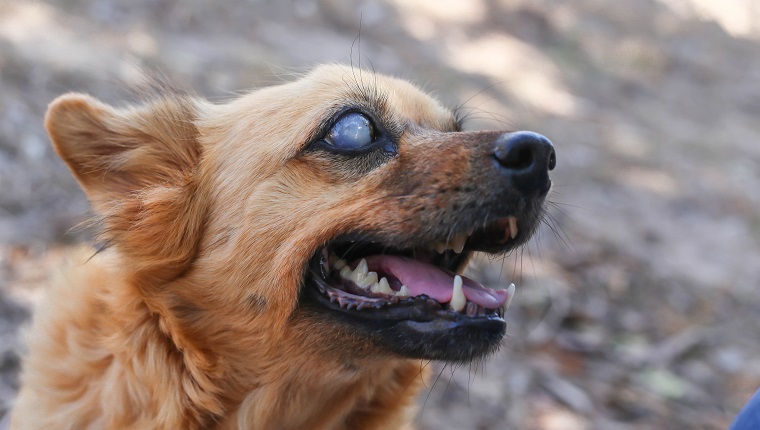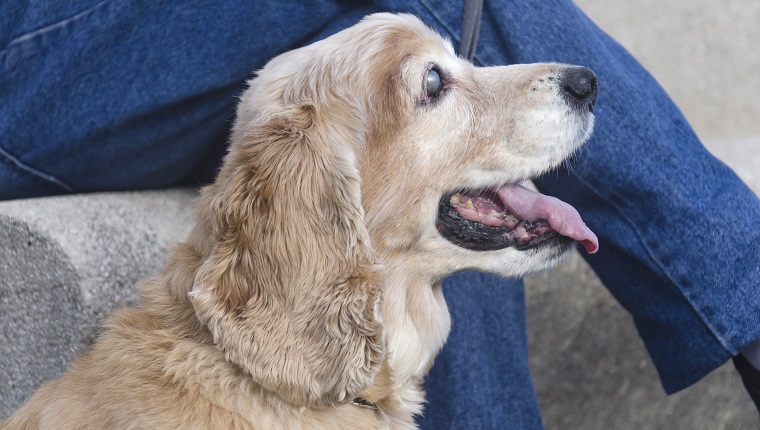No doubt — whether you are a new adopter and are bringing a blind dog into your house for the first time, or you are a longtime dog owner whose dog is living with deteriorating sight, it will be an adjustment for both of you.
Finding out that your dog is blind can be a scary bit of news at first; wondering how you and your dog will adjust can leave you feeling sad and unsure.
However, dogs can live happily without their sense of sight and adjust with the help of their humans. Here are a few things you should know if your dog is losing their vision or if you’re planning to adopt a blind dog into your home.
Blind Dogs Can Live Happy Lives
Karen Belfi, former president of the Blind Dog Rescue Alliance, wants the public to know that blind dogs can live normal, happy lives. “I do everything with my blind dogs that I do with my sighted dogs,” she says.
Her dog, Pete, a Siberian Husky-Beagle mix, lost his eyes due to injuries incurred when he was hit by buckshot. Though he is now blind, Belfi says he is as capable as a dog with sight. “You would never believe he is blind if you saw him run around,” she says.
The most important bit of advice Belfi has for parents of blind dogs is not to coddle them. “The dog needs to learn to get around,” she says, “and carrying them and babying them won’t help them learn.”
Dawn Rehus, a certified pet training instructor, has ample experience working with blind dogs and their humans. “Blind dogs can do almost all things a seeing dog can,” she says. She adds that most of the time, a dog can adjust to blindness quickly.
Prepping Your Home For A Blind Dog

Dogs can adjust to navigating around the house using their senses of smell, touch, and hearing, which all become elevated when they lose their sight.
Your first step should be to get on your dog’s level. Take a look around your home to see if there’s anything a dog might trip over or any dangerous areas that they could wander into. Stairways or high platforms should be off limits.
Use scent markers and mats with different textures to mark doorways or obstacles the dog could bump into. And you may want to block off any stairs in your house or yard with doors, baby gates, or other barriers, at least initially.
It’s up to you to help your blind dog learn the layout of your home. Rehus recommends first leading your blind dog through the house on a loose leash.
“Tension should only be applied if the dog is heading into danger. Most people are surprised how little this happens — their instincts can be amazing,” she says.
If your dog is having a lot of difficulty getting around, Belfi recommends building or buying a hoop and harness. The hoop goes around the front of the head and will let the dog know when they’re about to bump into an obstacle so that they can turn and avoid a collision.
Sometimes, dogs can have trouble locating their water bowls. If you find that this is the case with your dog, there are plenty of dog bowl water fountains on the market that you can try. Your dog will be able to hear the water, leading them to their bowl.
“Be sure it is for drinkable water, and not a decorative fountain, however,” Belfi warns.
Approaching & Greeting A Blind Dog
Because a blind dog can’t see you, it’s important to remember that they may be a little hesitant or defensive at first.
“Most blind dogs are very sensitive to movement,” Rehus advises. “People generally want to put their hand in the dog’s face or pet them right away.”
Rehus recommends a gentler, gradual approach to greeting a blind dog. “A blind dog – as well as a seeing dog – should always be allowed to approach a person at their own will, be given time to smell the air and pick up the scent of the person,” she says.
Belfi agrees, adding that it’s important to make a little bit of noise on your approach to let the dog know that you’re there. “I would greet them first by voice,” she advises, “then let them sniff your hand, then pet.”
Children should always learn how to approach a dog properly, but this is especially true with visually impaired dogs. Teaching a child to greet a blind dog in a calm, gentle manner will make for a comfortable experience for both kid and canine.
When introducing your blind dog to other pets, Rehus advises to do so with your sighted pets on leashes and your blind dog off-leash. Having the seeing animals on-leash can give you control of them, while your unleashed blind pooch can leave if scared.
“If they become frightened the last thing you want is for their flight response to be compromised,” she says.
Belfi suggests fitting your pets’ collars with tags that jingle. “The blind dogs can hear them, and no one can get snuck up on,” she says.
Training A Blind Dog

When training your blind dog, make sure to use positive reinforcement and consistency in your commands and methods.
Rehus recommends using a clicker for training because it provides the dog with a consistent sound that they can associate with a positive reward.
Clicker training promotes catching behavior; when your dog performs a good behavior, mark it with a click, and reward them with a small, healthy treat. “Eventually, the dog will offer the behavior on their own,” Rehus explains. “Then you can attach the cue.”
Many of the commands you will teach your blind dog will help them get around your house and yard safely.
“I teach ‘watch’ when something is in the dog’s way. They learn to stop when I say that, and feel for something in front of them,” Belfi explains. “I also teach ‘step up’ and ‘step down’ for stairs and curbs.”
Using simple, clear, and consistent commands will help your dog immensely in the learning process.
Consider attending an obedience class with a professional pet trainer. The trainer can guide you and your dog along in the learning process and can be on hand to tackle any questions you might have.
Have you ever taken care of a blind dog? What adjustments did you make to your home or training methods to help your pet? Let us know in the comments below!




